Physical Address
304 North Cardinal St.
Dorchester Center, MA 02124
In almost all instances, tests and/or studies can help elucidate the cause of a problem. However, of equal, and possibly greater, importance is the potential for a test to introduce data that clouds the picture and adds complicating factors that can result in a delay in diagnosis or in arriving at the wrong conclusions.
In the evaluation of a patient with pain, particular caution must be taken to guard against the thought process of “if the test is abnormal, that must be the cause of the problem.”
Electrodiagnostic medicine (EDX) is potentially a powerful tool that allows for the objective quantification of the function of the peripheral nervous system. However, in all instances, the data must be interpreted within the context of the patient, and ideally, the test should be tailored to address questions and concerns that arose from the detailed history and physical exam that preceded the EDX study.
The question of the utility of EDX in the evaluation of a patient with pain, and more importantly, the limitations and potential pitfalls must always be first and foremost in the mind of the EDX physician and referring physician when setting up, performing, and interpreting the data.
Understanding the role of EDX in evaluating the pain patient is critical to avoid the over and under interpretation of the data. In all instances, the successful evaluation and treatment of a patient lie in the blending of the history and physical with appropriate data utilization.
Electrodiagnosis is a broad term that includes multiple techniques. This chapter will focus on needle electrode examination (NEE) and motor and sensory nerve conduction studies (NCSs), including late responses. Needle electromyography (EMG) and standard motor and sensory nerve conduction techniques, including in limited scenarios the use of late responses, can be useful adjuncts to the physical examination of patients in pain, with the understanding that the history and objective findings on the physical exam drive the electrodiagnostic examination (EDX) investigation, as opposed to the pitfall of attempting to retrofit the EDX data to the patient.
Conditions in which EDX may be of use include painful peripheral neuropathies, entrapment neuropathies, traumatic nerve injuries, radiculopathies, lumbar spinal stenosis, arachnoiditis, and painful myopathies.
More recently, there has been an increased reliance on anatomic measures such as intradermal nerve biopsy for small fiber neuropathy and magnetic resonance imaging for larger neural structures. Unfortunately, this “anatomic” approach is a snapshot in time and cannot fully delineate if the process is acute versus chronic nor assist in delineating the relapsing/remitting nature of many chronic pain disorders. Additionally, the “anatomic” approach fails to recognize the inherently complex nature of pain, a subjective experience with a myriad of modifiers that can only be correlated with the clinical picture.
The problems inherent in applying electrodiagnostic techniques to diagnose and manage pain are no different from those encountered in history taking, physical examination, radiologic evaluation, and therapeutic diagnostic testing (e.g. nerve blocks). Pain is a subjective experience, often without an objective, gold standard test. As such, the final diagnosis of the probable cause and presumptive treatment of a pain syndrome is a clinical one that can be supported only by relevant data, including findings on EDX.
The standardization of EDX techniques and robust data on normal individuals allows for the objective electrophysiologic assessment of the peripheral nervous system to gain an overall understanding of the distribution of abnormalities, if present, or relative normalcy, if not. The distribution of abnormalities may correlate strongly with the cause of a disease process causing pain or can be an incidental finding of unclear significance. The ability to distinguish between these two scenarios rests in the correlation of EDX data to symptoms. Hence the physical exam findings and historical data should drive the EDX study. EDX testing should not be undertaken to address the question of “let us see what could be wrong?”
Questions that can be posed and potentially answered through using electrodiagnostic techniques include some of the following:
Is a disease of large myelinated nerve fibers present?
What is its pattern of distribution? Is it mononeuropathy, polyneuropathy, or mononeuritis multiplex?
Does it equally affect motor and sensory fibers, or does one dominate?
Does the distribution of abnormalities suggest involvement at the nerve root, plexus, or more distal nerve level?
If there is a disease process involving a single (or multiple) nerve, such as injury or compression, is it improving, worsening, or static? Understand that this may require serial studies over time.
Is the nerve involved motor, sensory, or mixed?
Is a disease of muscles present?
Is the process one of nerve, muscle, or both?
Are small fibers selectively involved, or is this mainly a large-fiber disorder, or are both involved? (Understand that patients with isolated small fiber neuropathy will have normal EDX findings on needle EMG and NCSs. In these instances, skin biopsy assessment for intra-epidermal nerve fiber density and sweat gland analysis may aid in the diagnosis).
Is there autonomic and somatic involvement?
Are more proximal structures rather than distal ones involved?
Is the central nervous system involved? Standard EDX testing in this scenario is utilized to rule out peripheral nervous system involvement.
Is the process acute, chronic, acute on chronic, or old?
EDX testing satisfies two fundamental steps in the assessment of a neuropathic pain syndrome before any attempt at therapy: (1) rigorously establishing the presence or absence of a peripheral nervous system lesion and (2) determining the relevance of an established peripheral neuropathic lesion or myopathic process to the subjective clinical complaint. In addition, with the advent of new treatments, including enzyme replacement and the potential insertion of genetic material into cells, early diagnosis and the ability to monitor treatment outcomes objectively become of great importance. Recent enzyme replacement therapy for Pompe’s disease is an example of the potential diagnostic, therapeutic, and prognostic importance of electrodiagnosis.
The parent organization of electrodiagnosis is the American Association of Neuromuscular and Electrodiagnostic Medicine (AANEM), which has promulgated a Recommended Policy for Electrodiagnostic Medicine Position Statement. This document seeks to lay out the scope of electrodiagnosis by using consensus expert opinion to ensure adequate examination while attempting to conserve scarce resources by listing the indications for testing and the maximum number of studies per diagnosis in 90% of cases. Since there has been some abuse of the number of studies done on patients and since many pain specialists are not familiar with the techniques of electrodiagnosis, this serves as an important source of information on the appropriate measures to be used when these diagnostic methods are being considered.
EDX is a method of testing both the anatomic and physiologic integrity of lower motor neuron structures (anterior horn cells, nerve roots, plexuses, peripheral nerves, neuromuscular junction, and muscles), sensory components, and some spinal and brainstem reflex pathways. The term electromyography previously caused considerable confusion because strictly speaking, it was NEE of muscle function but often was expanded to include nerve conduction velocity (NCV) or NCSs and other tests. However, its common usage has come to mean needle EMG, determination of NCV, and less frequently, testing such as the H-reflex and F-response, cranial nerve reflexes (e.g. the blink reflex), and studies of the neuromuscular junction. The all-inclusive term EDX (electrodiagnostic examination) is used here to avoid confusion among tests.
A puzzling dichotomy regarding pain and electrodiagnostic testing in the medical literature is well documented. The reason for the paucity of references appears to be at least in part the attitudes of pain specialists themselves, who point out that “large caliber afferent fibers are physiologically unrelated to pain,” a sub-modality mediated by small caliber fibers. Additionally, the test is unable to explore the basis for positive sensory phenomena generated by dysfunction even of large caliber afferent channels.
All electrodiagnostic equipment can fundamentally be thought of as containing the following componentry:
Electrodes: Electrodes allow for the recording of an evoked signal. The recording device may be surface or needle electrodes. The size (area) of the recording surface directly impacts the amplitude and duration characteristics of the recorded response. As such, the consistency of electrode size is paramount when comparing studies across time and between examiners and institutions.
Stimulator: Stimulators can be constant voltage or constant amperage; typically, they are now constant current. An understanding of Ohms law (V=IR) quickly allows one to appreciate that If R (resistance) varies (skin impedance, sweat) over time, holding I (current) constant allows for the maintenance of a constant and stable electrical field (load despite variations in resistance). This results in improved tolerance for the test with less pain (stable intensity) and more stable recordings over time.
High-gain differential amplifier: Differential amplifiers have both high frequency (low pass) and low frequency (high pass) characteristics. The frequencies that pass between the filters is the band path and is adjustable for environmental situations. Changing the amplifiers will impact on amplitude, duration, and latency of the recorded responses. It is critical to appreciate this phenomenon to avoid over or under interpretation of data accumulated in electrically challenging environments such as ICUs.
Recording display or central processing device with A to D conversion capability: A to D conversion refers to the mathematical manipulation of the analog signal into a stable static waveform “seen” on the oscilloscope screen. The waveform “seen” is the digital representation of the analog wave resulting from multiple digitized (x, y coordinate) points. ,
The EMG apparatus amplifies and displays biologic information derived from either surface or needle electrodes. Electrical information may be recorded from muscles, nerves, or other nervous system structures and is displayed on an oscilloscope. Besides the visual display on the oscilloscope, a permanent recording may be made, audio amplification may allow it to be heard over a loudspeaker, and analog-digital analysis of signals may be used. Nerves are electrically stimulated to measure conduction. ,
For NCSs, skin surface electrodes are generally used for recording compound muscle or nerve action potentials. Rarely, needle electrodes are used.
For needle EMG, needle electrodes are used. They are typically monopolar or concentric. Each has unique characteristics and does impact on amplitude, duration, and phase complexity. Understanding these factors is important when comparing studies conducted by different examiners and different labs. , ,
For sensory testing, ring electrodes, self-adhering surface electrodes, and disc electrodes are used for measurement ( Fig. 19.1 ). Modern EMG equipment is manufactured by numerous companies and is generally standardized to allow reliable and reproducible testing by different laboratories, but normative data, including data for special populations such as geriatric, pediatric, diabetic, and even active workers, may differ among laboratories and require standardization by each laboratory.
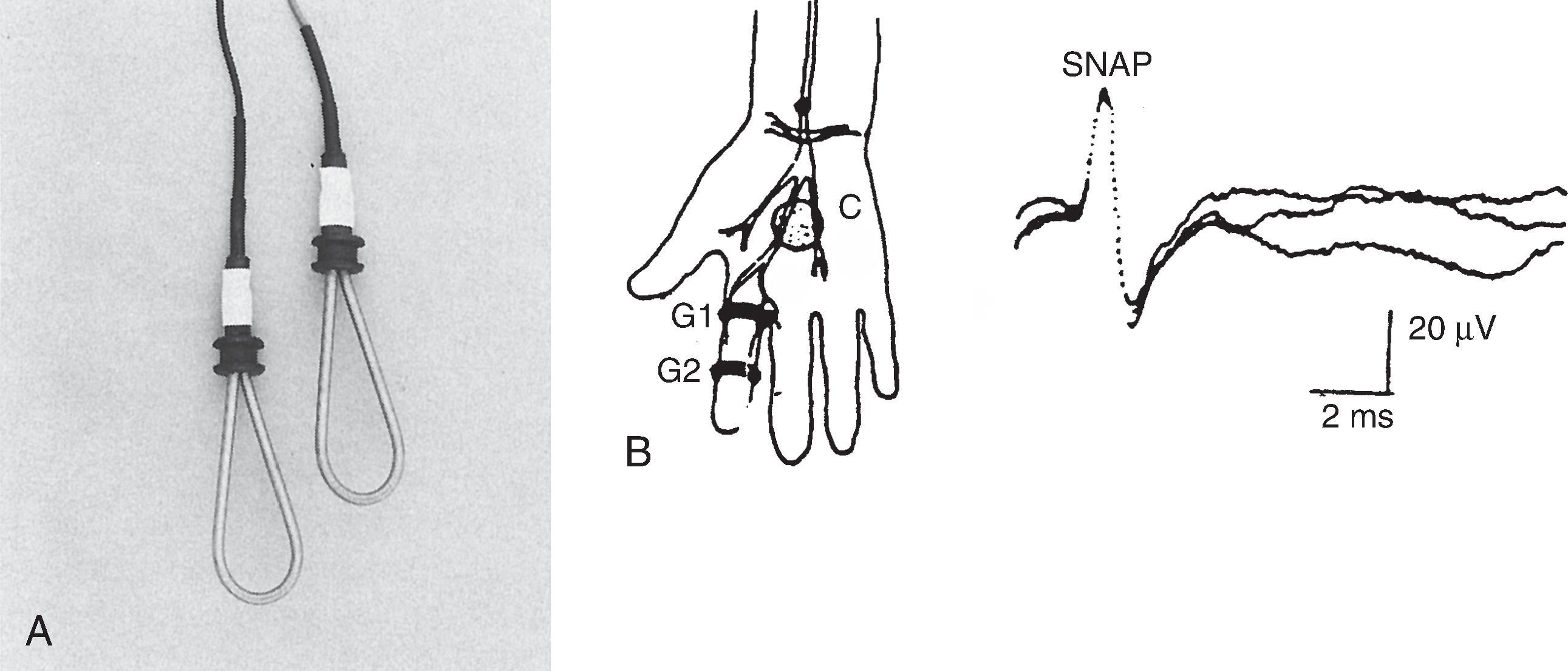
NEE is an invasive procedure, but complications are rare. However, patients should be apprised of them. The most common is transient muscle soreness. Aseptic precautions should be observed. Safeguards for testing include extra care with patients who are taking warfarin or other anticoagulants or who have hemophilia or other blood dyscrasias, but since most muscles tested are superficial, they can easily be compressed, and the bleeding abated. Severe thrombocytopenia is a relative contraindication and should be considered carefully. Patients positive for human immunodeficiency virus (HIV) represent a transmission risk, but the use of disposable needles (which should be universal) protects against this hazard. One should carefully consider persons with a cardiac pacemaker or transcutaneous stimulator when doing stimulation for NCSs. Certain muscles, such as the rhomboids and abdominals, which are sometimes interrogated by NEE in pain patients, and the diaphragm (rarely), carry a risk for infectious peritonitis and pneumothorax, respectively. Beyond placing a needle through an infected site, there are probably no absolute but only relative contraindications to EMG. Extremely anxious patients and some children occasionally require some sedation. Aftereffects are negligible, with rare bruising, although occasionally a highly disturbed, suggestible, or litigious patient may complain of increased pain or disability vehemently.
When recording extracellularly, as with EMG, the electrode picks up the action potential as it is conducted through the medium that surrounds the active fiber. The impedance of the external medium is small compared to the impedance of the fiber interior, and hence the voltage of the extracellularly recorded potentials is maximally only 2%–10% of the intracellularly recorded potential changes. The functional unit ( Fig. 19.2 ) in reflex or voluntary activity is the motor unit; a motor unit is the group of muscle fibers innervated by a single anterior horn cell.
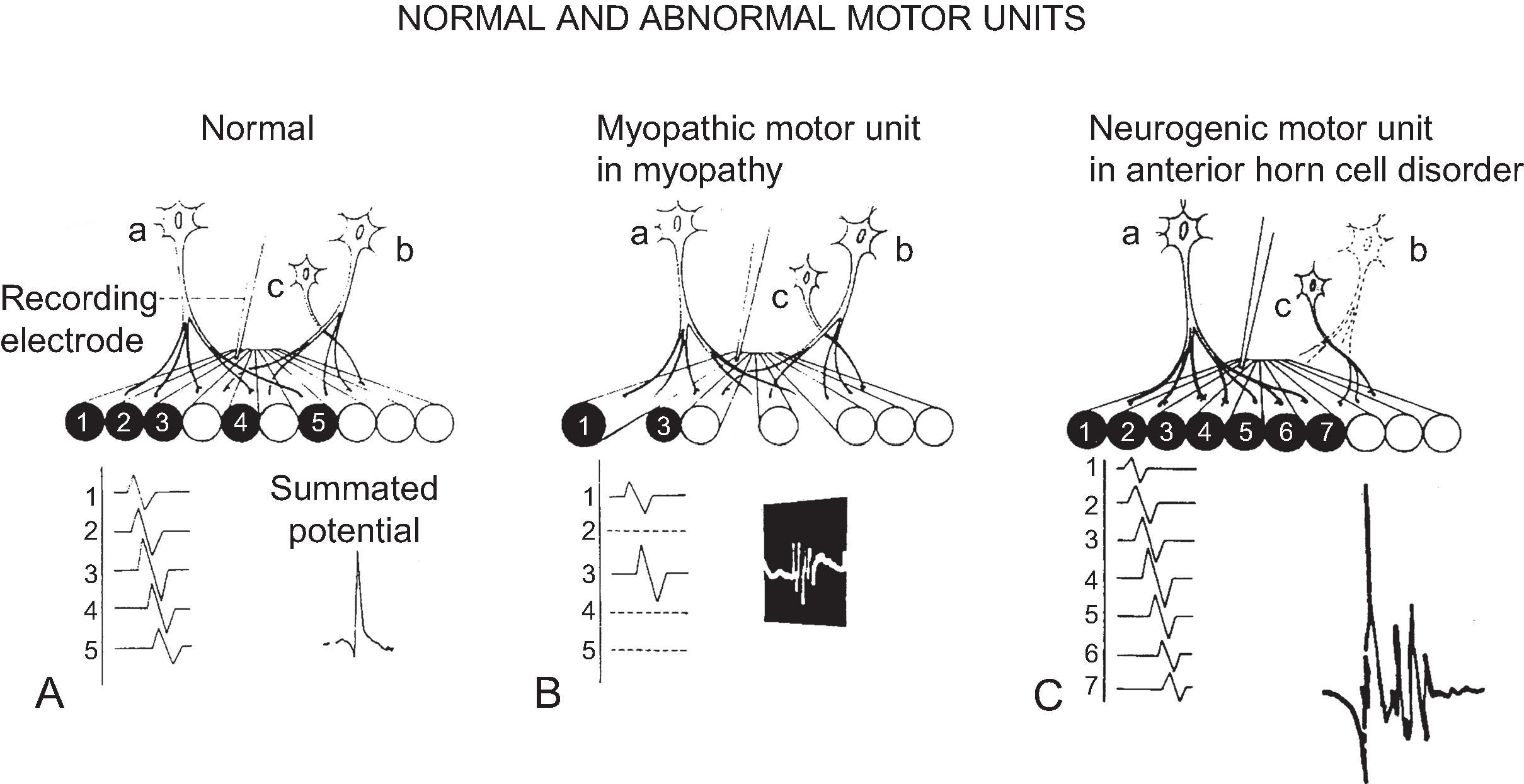
Conduction along the fine intramuscular branches of the anterior horn cell axon occurs so rapidly that all muscle fibers in a motor unit are activated nearly simultaneously. The number of muscle fibers per motor unit varies considerably from muscle to muscle; for example, in the gastrocnemius, the motor unit consists of about 1600 muscle fibers, whereas in the small muscles of the eye, there are only 5–10 fibers. The motor units in various muscles cover different areas of the muscle’s cross-section (e.g. brachial biceps, 55 mm; rectus femoris, anterior tibial, and opponens pollicis, 8–9 mm). The distribution of fibers is such that fibers from several different motor units are intermingled, which is why four to six motor units can be identified by EMG from the same intramuscular recording point.
In normal muscle, these single motor unit potentials can be differentiated only during weak voluntary effort. Utilization of sub-maximal effort during the recruitment phase of needle EMG recording and evaluation is critical to allow for the objective assessment of motor unit morphology and recruitment parameters. The potentials from different motor units are recognized by their frequency of discharge, which varies for each motor unit (some are more or less excitable). The various potentials often differ in appearance because of the differential distance of the recording electrode from the individual fibers of the activated motor units and the differential distribution of the motor end plates in the several units within “range” of a concentric or single needle electrode in one position in the muscle.
An upward deflection on the oscilloscope is considered electrically negative, and a downward deflection is considered electrically positive. Motor unit morphology will vary as a direct consequence of distance from the recording electrodes. Only motor units with an initial negative deflection and a rapid rise time should be evaluated in terms of amplitude, duration, and presence of an abnormal number of turns or phases. These parameters are critical in evaluating potential neuropathic and myopathic processes and help determine the acuity versus chronicity of the suspected disorder. , ,
The cell membrane (axolemma) of a nerve axon separates the intracellular axoplasm from the extracellular fluid. The unequal distribution of ions between these fluids produces a difference in potential across the cell membrane. This resting potential is about 70 mV and is negative on the inside with respect to the outside of the cell membrane. When a nerve fiber is stimulated, it causes a change in the membrane potential; a rapid but brief flow of sodium ions occurs through ionic channels inward across the cell membrane and gives rise to an action potential. ,
The way in which an action potential is conducted along an axon depends on whether the axon is myelinated or unmyelinated. In a myelinated fiber, the action potential is regenerated only at the nodes of Ranvier, resulting in action potentials that “jump” from node to node or saltatory conduction. The velocity of nerve conduction depends on the diameter of the myelinated fiber. Small myelinated fibers may conduct as slowly as 12 m/s, whereas large motor and sensory fibers conduct at a rate of 50–70 m/s in humans. In an unmyelinated fiber in humans, the conduction rate is about 2 m/s. ,
Several factors affect conduction velocity other than whether the axon is myelinated:
Temperature of the limb (low temperatures decrease conduction velocity).
Age of the patient (infants have slow conduction velocities and older adults have increasingly slowed conduction velocities). ,
Height of an individual (increased height may increase the internodal distances of the nodes of Ranvier and potentially lead to erroneous interpretation of numeric data).
EMG must be combined with clinical examination of the patient by the electromyographer. This includes grading of muscle strength and elicitation of muscle stretch reflexes. It is of prime importance for the electromyographer to personally correlate the clinical data and that obtained by EMG. With the understanding that the EMG examination is an extension of the clinical examination, the patient must be evaluated fully, and the problem tentatively assigned to the portion of the anterior horn cell system that seems most likely to be involved. The electromyographer determines the segment or segments of the peripheral nervous system suspected to be involved, and the examination is planned to either substantiate or invalidate the presumptive clinical diagnoses. EDX data that are discordant with the clinical examination are not to be ignored, but rather an explanation and rationale for that data are required, and its significance, or lack thereof, needs to be addressed.
When the needle is inserted into a normal muscle, it evokes a brief burst of electrical activity that lasts no more than 2–3 ms after the needle ceases to move. This point is critically important because persistent pressure on the needle can potentially lead to spurious determination of increased insertional activity and possible pathologic condition. , , This activity is described as insertional activity and is generally 50–250 mV in amplitude ( Fig. 19.3A ). These insertional potentials are believed to represent discharges from muscle fibers produced by injury, mechanical stimulation, or irritation of the muscle fibers.
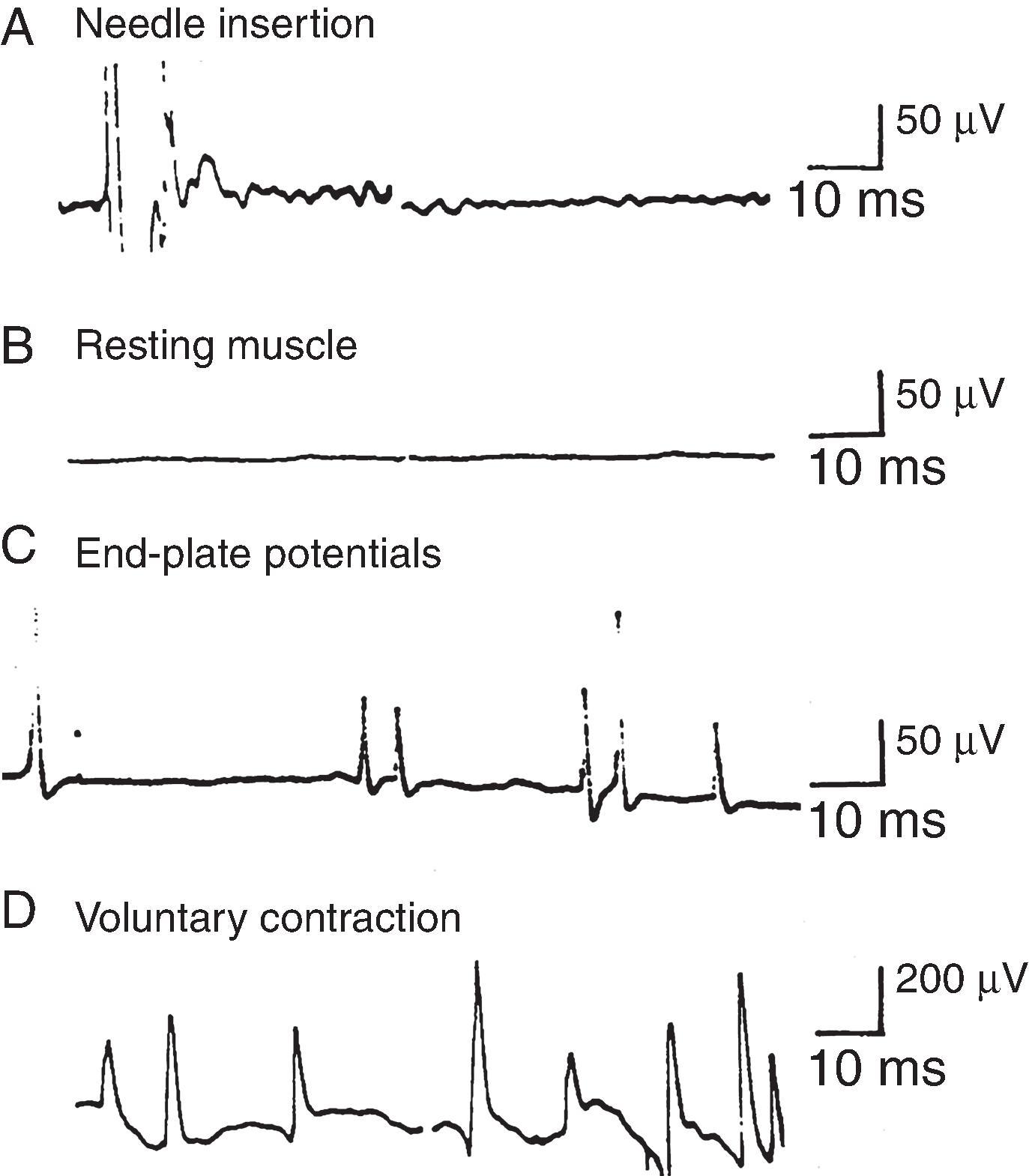
When the needle is stationary, and the muscle is relaxed, there is no electrical activity present in normal muscle except when the needle is in the area of the endplate ( Fig. 19.3B ). Two types of endplate “noise” are normal ( Fig. 19.3C ): (1) low amplitude and undulating, which probably represents extracellularly recorded miniature endplate potentials as a result of the release of individual quanta of acetylcholine, and (2) high amplitude highly irregular intermittent spike discharges, which probably represent non-propagated discharges of single muscle fibers excited by intramuscular nerve terminals irritated by the needle. Any other spontaneous activity at rest is abnormal. An increased duration of insertional activity may be seen with loss of innervation or with the primary disease of muscle fiber. Reduction may occur in patients with myopathies or more advanced degeneration in which muscle tissue has been replaced by fat or fibrous connective tissue.
The voluntary activity of the muscle is analyzed after the muscle is studied at rest ( Fig. 19.3D ). Electrical activity (termed a motor unit action potential) is noted. A motor unit refers to the number of muscle fibers supplied by one motor neuron and its axon. This number varies from muscle to muscle and maybe as few as 10 to more than 1000 muscle fibers. When a motor neuron discharges, it activates all the muscle fibers of the motor unit.
The force of contraction determines the number of motor units brought into play. , , This begins with a single motor unit that fires and can be identified on the screen by its distinctive morphology. As effort is increased, other motor units come into play, which can still be individually discerned and have their own individual morphology and audio representation on the loudspeaker. As the contraction increases, the firing rate of each individual motor unit action potential increases, and the action potential is subsequently joined by other motor unit action potentials, whose firing rates also increase. This phenomenon is known as recruitment ( Fig. 19.4 ). In normal muscles, the strength of a voluntary muscle contraction is directly related to the number of individual motor units recruited and their firing rate. Analysis of motor units includes (1) waveform, (2) amplitude, and (3) interference patterns.
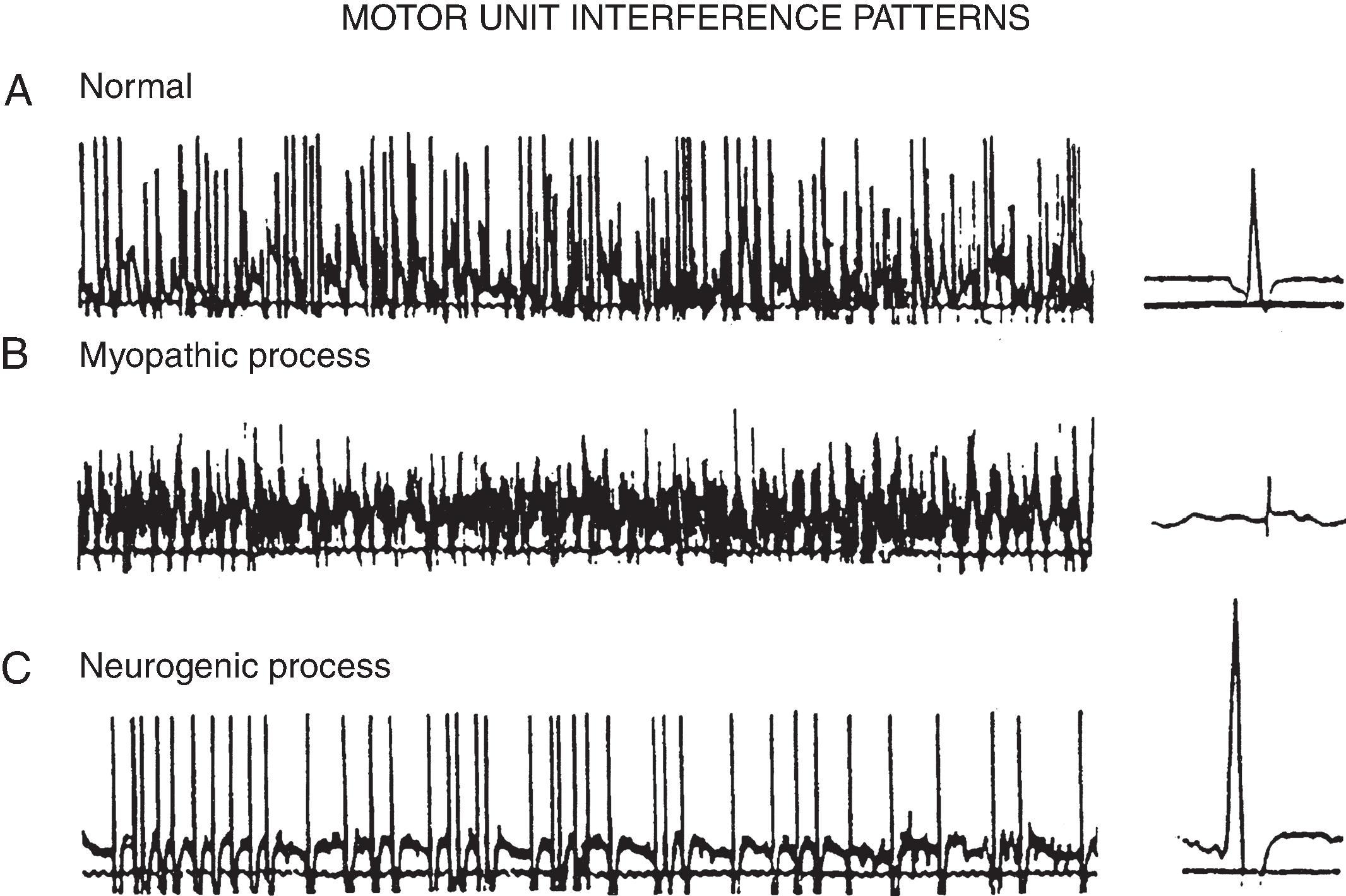
Typical motor units are biphasic or triphasic. The number of phases is determined by the “baseline crossings.” Motor units that cross the baseline more than four times are called polyphasic motor units. Polyphasic motor units are determined by the number of baseline crossings plus one. Four baseline crossings plus one equals five, and by definition, that is a polyphasic motor unit potential. Changes in phase not associated with baseline crossings are referred to as turns and can be seen as a consequence of a reinnervated maturing polyphasic motor unit potential after axonal injury in the past. Though occasionally seen in healthy muscle, they do not exceed 15% of the total number of motor units. In some muscles, polyphasic motor units are more prevalent. Polyphasic potentials are a measure of fiber synchrony. ,
The amplitude depends on the number of fibers in the motor unit, the synchronization of the firing of the fibers in the motor unit, and the type of EMG needle used. Monopolar needles are associated with higher amplitude potentials than bipolar or coaxial needles are. Normal amplitude ranges from 1–5 mV. Because the motor unit is the sum of the action potentials of each muscle fiber of the unit, a large motor unit has a larger amplitude; conversely, a smaller motor unit has a smaller amplitude ( Table 19.1 ). , ,
| Nerves | Amplitude (Avg.) | Distal Latency in msec (Avg.)∗ | Conduction Velocity in m/sec (Avg.) |
|---|---|---|---|
| Median (sensory) | 10–85 µV (20) | 2.0–3.7 (3.2) | |
| Ulnar (sensory) | 5–70 µV (15) | 1.6–3.2 (2.8) | |
| Radial (sensory) | 10–60 µV (18) | 1.7–2.8 (2.4) | |
| Median (motor) | 5–25 mV (8) | 2.0–4.0 (3.3) | 48–69 (54) |
| Ulnar (motor) | 5.5–20 mV (8) | 1.6–3.1 (2.6) | 50–69 (55) |
| Sural (sensory) | 3–38 mV (8) | 2.3–4.6 (4.1) | 41–61 (46) |
| Peroneal (motor) | 2.5–18 mV (4) | 2.3–6.0 (4.1) | 41–58 (45) |
| Posterior tibial (motor) | 4–38 mV (11) | 2.1–6.0 (4.3) |
With maximum voluntary effort, a large number of motor units are brought into play, and their firing rate increases. They tend to “interfere” with each other and are not recognized further as individual units. This gives rise to a situation called an interference pattern ( Fig. 19.4 ). A normal muscle has a “full” interference pattern. With improvement in EMG equipment and the development of A to D conversion, interference pattern analysis is of limited utility. Analysis of sub-maximal contraction allows for evaluation of individual motor units, which in turn offers much richer detail and data in the evaluation of suspected neuropathic or myopathic processes.
Various abnormalities may occur that indicate the presence of muscle dysfunction, which can be neurogenic or myogenic in etiology. The appreciation for the dynamic interplay and synchrony of abnormal EDX findings with a detailed, organized physical exam, buttressed by patient specific historical data, will ease the delineation of radiculopathy, generalized neuropathy, focal neuropathy, or mononeuropathy, or plexopathy.
The following are needle abnormalities in abnormal muscle:
Insertional activity (decreased or increased).
Spontaneous activity (fibrillations, positive sharp waves, CRDs [complex repetitive discharges] or fasciculations) ( Fig. 19.5 ).

Abnormalities in voluntary motor unit activity, especially recruitment ( Fig. 19.4 ).
Abnormal motor unit morphology (e.g. excessive or extreme polyphasia).
NCSs are of value in the following cases:
Determining whether a disease of the nerve is present.
Determining the distribution of neuropathy (e.g. mononeuritis, polyneuropathy, mononeuritis multiplex; this may be a valuable point in the differential diagnosis of the cause of a neuropathy).
Determining at what point in a nerve a conduction block is present and locating an entrapment site.
Studying the progress of disease of a peripheral nerve (e.g. Is it getting better? Worse? Staying the same?).
Seeing whether reinnervation of a previously sectioned nerve has taken place.
Establishing in a disease of the myoneural junction (e.g. myasthenia gravis) the fact that conduction along the nerve is adequate or normal. ,
There are a few important limitations to the use of NEE in diseases of muscle and nerve, but particularly muscle. Some disorders may not result in abnormal findings on EMG, including certain congenital conditions and endocrine disorders such as steroid myopathy and polymyalgia rheumatica, an important cause of muscle pain and weakness in an older person. Rarely are the findings specific for a particular type of myopathy within the family of primary muscle disorders. ,
Conduction velocity studies are carried out by inserting a needle electrode into a muscle innervated by the nerve under study or by the use of surface electrodes over that muscle ( Fig. 19.6 ). For example, the first dorsal interosseous muscle may be examined to determine the function of the ulnar nerve ( Fig. 19.7 ). The nerve is stimulated at the elbow in the case of the ulnar nerve, and the latency of the response is determined. The response is generally a spike-like large motor unit action potential. The ulnar nerve is then stimulated in the wrist or the axillary region, or both. The difference in latencies between the two points of stimulation and the distance between the two points of stimulation provide the basis for the calculation of conduction velocity.
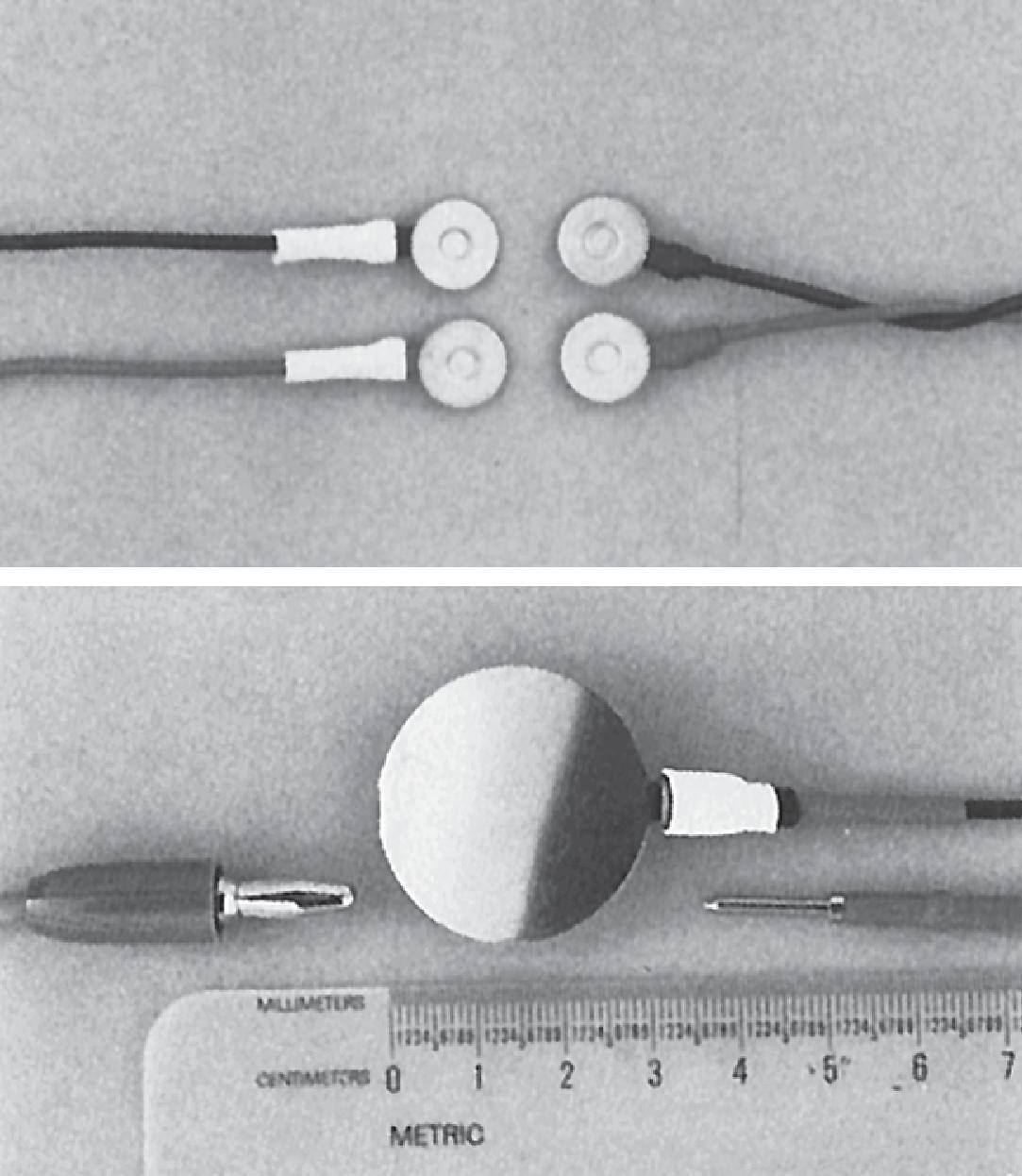
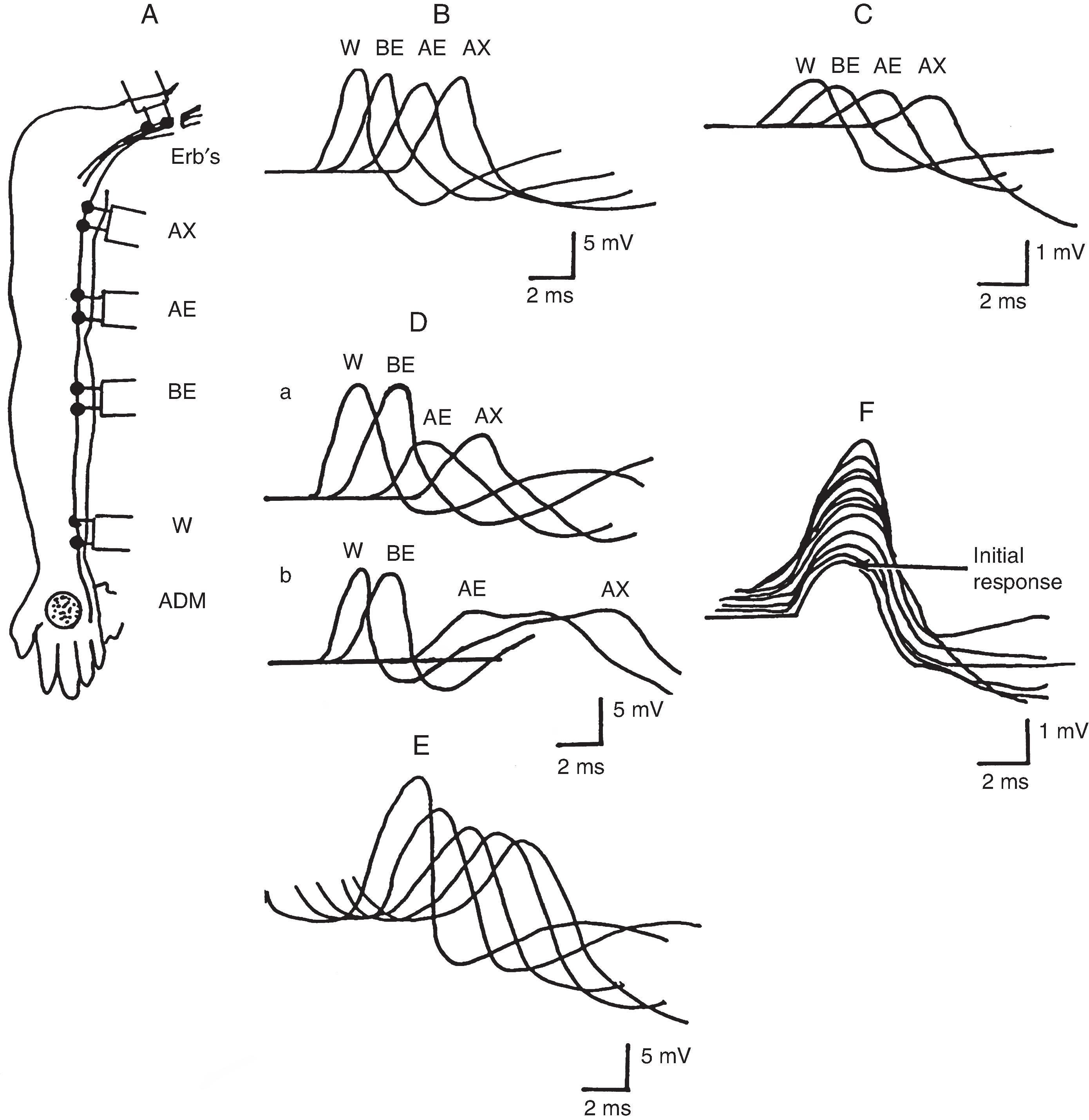
Become a Clinical Tree membership for Full access and enjoy Unlimited articles
If you are a member. Log in here